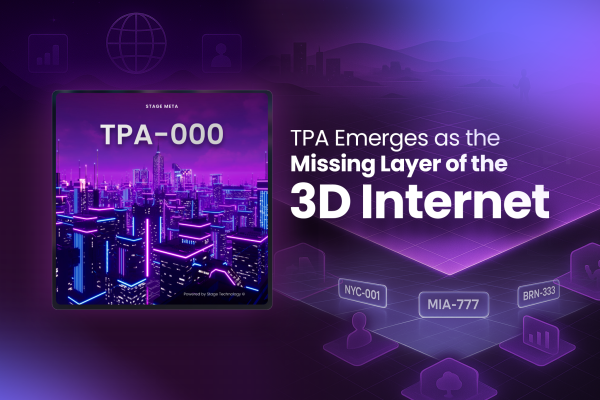New protocol unlocks interoperability and discoverability across immersive platforms, just as DNS did for the early web.

Miami, Florida, United States, 10th Apr 2025 – After more than a decade of innovation in Spatial Computing—augmented reality, mixed reality, and immersive 3D environments—mainstream adoption still lags. The headsets are here. Interfaces are evolving. Tech giants like Apple, Meta, and Google have invested billions.
So, what’s still missing? Infrastructure.
Today, Stage Meta reintroduces Teleport Plaque Address (TPA) as the foundational protocol that could finally unlock the immersive internet. TPA acts as a universal address system for 3D spaces, providing a standardized layer for navigating and connecting spatial environments—just as DNS did for the early web.
“Spatial Computing doesn’t need more hardware—it needs a way to unify it all,” said Vito Akbari, CEO at Stage Meta. “TPA makes immersive content addressable, linkable, and interoperable. It’s not just a technology layer—it’s the beginning of an open 3D internet.”
What Is TPA?
Teleport Plaque Address (TPA) gives each 3D space a persistent, recognizable identity—think of it like .com for the spatial web. A TPA might look like NYC-001, MIA-777, or BRN333, and can be activated across major XR devices like Apple Vision Pro, Meta Quest, and other immersive platforms.
TPA enables:
- Cross-platform navigation between immersive environments
- Voice-activated access and deep linking to spatial destinations
- Discovery and interoperability between 3D applications
TPA isn’ta virtual world—it’s the connective system that makes virtual worlds work together.
Real Use. Real Adoption.
TPA is already in use today.
- Stage Meta, the first native platform built entirely with TPA, is fully operational
- Global brands including Coldwell Banker, SLS, and Delphinus have claimed andactivated TPA domains
- Over 1,200 TPA addresses have been registered, with third-party developers integrating the protocol into next-gen spatial apps
Why TPA—and Why Now?
As Spatial Computing accelerates and XR platforms multiply, the landscape becomes increasingly fragmented.
TPA brings order to chaos.
It acts as the address layer that powers usability, discoverability, and seamless interaction—turning isolated XR demos into a unified spatial ecosystem.
“The 3D internet won’t reach scale without standardization,” said Akbari. “TPA is that standard.”
About TPA
Teleport Plaque Address (TPA) is a spatial domain protocol that assigns persistent identifiers to immersive environments. Designed to serve as the DNS layer of the 3D internet, TPA enables discovery, interoperability, and seamless navigation across XR platforms.
Disclaimer: The views, suggestions, and opinions expressed here are the sole responsibility of the experts. No journalist was involved in the writing and production of this article.

